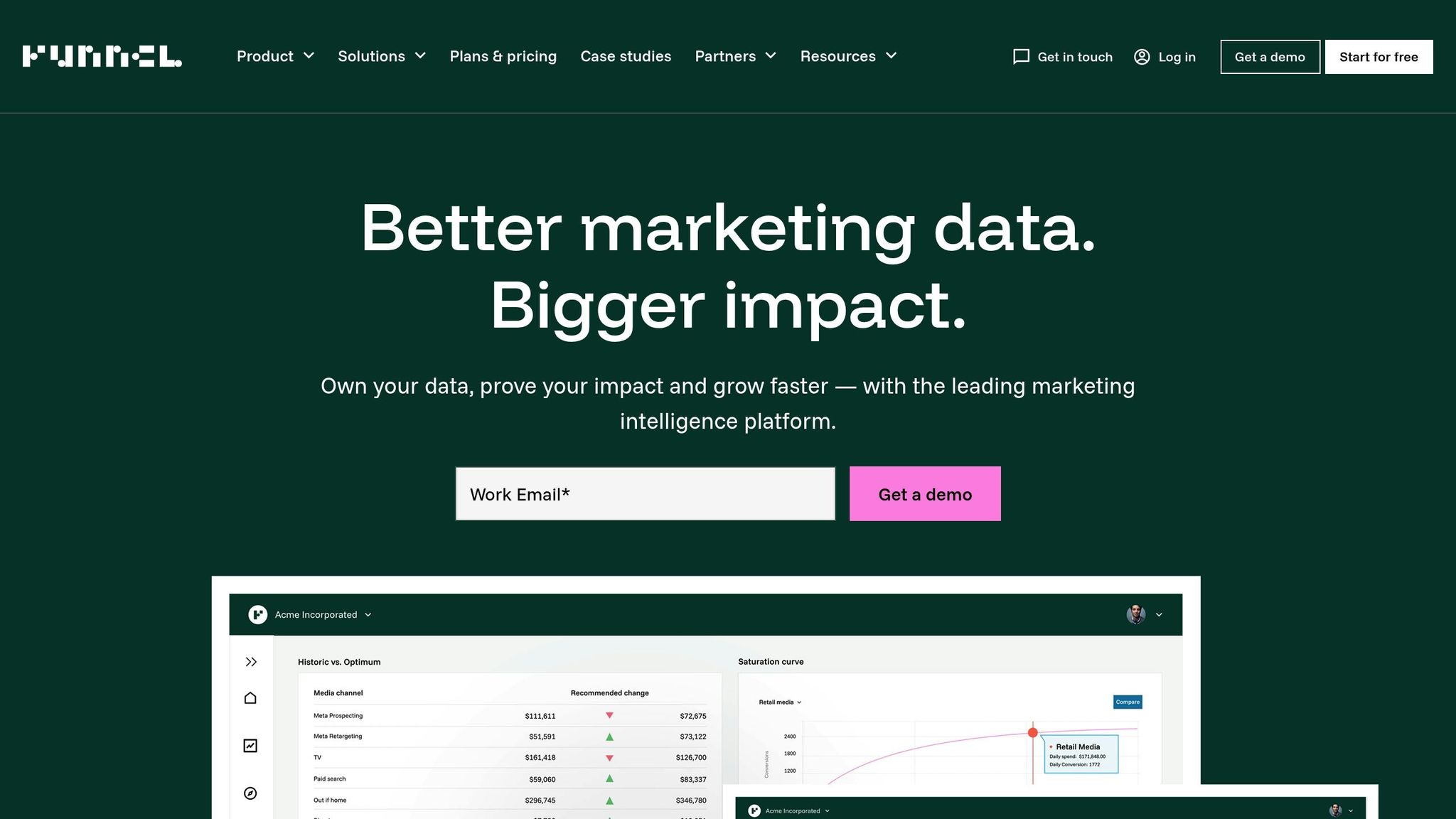


To effectively engage developers, shift from traditional marketing funnels to signal-based strategies that focus on real-time behavior and technical clarity.
Developers don’t respond well to traditional marketing funnels. They don’t want sales pitches, gated content, or nurturing campaigns. Instead, they value clear technical details, honest documentation, and tools they can test independently. This behavior makes them hard to track using conventional marketing methods.
To reach developers effectively, focus on signal-based marketing. This approach uses real-time behavioral data - like API usage or documentation visits - to identify interest and deliver practical, relevant content. Developers trust resources that solve problems, such as code examples, benchmarks, or guides, over sales-driven messaging.
Key Takeaways:
- Developers prefer anonymous research and peer recommendations.
- Avoid sales pressure; deliver upfront value through technical clarity.
- Signal-based marketing targets behavior, not funnel stages, for better engagement.
The solution? Respect developers' workflows by providing actionable, tailored resources based on their needs, not forcing them into outdated sales processes.
Why Marketing Funnels Fail for Developer Relations & What Works Instead
Why Marketing Funnels Don't Work for Developers
Traditional marketing funnels, like the AIDA model (Attention, Interest, Desire, Action), were created for consumers who follow structured buying behaviors. But developers don’t operate within these neat, linear stages. Instead, they rely on anonymous research and make decisions based purely on technical merit, leaving traditional funnels ineffective.
Developers are practical problem-solvers who prioritize access to detailed technical information. They don’t want to be guided through a staged process, and this disconnect creates deeper challenges: they reject sales pressure, value their anonymity, and demand straightforward clarity.
Developers Want Control, Not Sales Pressure
Developers are naturally skeptical of sales tactics. They’re quick to dismiss marketing strategies that hide information behind forms or rely on aggressive follow-ups. For them, protecting their time and staying focused on building software is far more important than engaging with sales-driven campaigns.
Traditional marketing funnels aim to capture leads early and push sales messages. But developers approach things differently - they prefer to do thorough technical research on their own and remain anonymous until they’re confident a tool fits their needs.
Anonymous Research Breaks Funnel Tracking

Developers’ preference for private evaluation creates a major challenge for marketers. Traditional metrics often fail to capture their decision-making process. As Calen Holbrooks, Vice President of Marketing at ZoomInfo, explains:
Most B2B buyers are working super hard to remain unknown to you - they tend to avoid forms at all costs.
Developers dive deep into anonymous research, leaving marketing teams with only a fragmented view of their journey.
US Developers Expect Direct, Clear Communication
Developers in the United States hold brands to a high standard of transparency and straight talk. They value honesty and consistency in messaging. Instead of vague promises or partial information, they expect complete technical specs, honest performance data, and upfront pricing details.
They also appreciate when companies acknowledge mistakes and take steps to address them. Brands that are open about their limitations, known issues, or roadmap challenges earn more trust. This preference for directness is evident in developers’ behavior - they often skip marketing pages entirely, heading straight to documentation, GitHub repositories, or community forums. They prioritize real-world code examples and peer reviews over polished case studies.
This demand for transparency is the “signal” developers look for, and it clashes with the rigid structure of traditional marketing funnels. Funnels can feel patronizing or manipulative to developers, eroding trust instead of building it. As a result, developers often bypass these systems and seek out information through self-guided, no-nonsense channels.
What Signal-Based Marketing Is and Why It Works
Signal-based marketing takes a fresh approach to reaching developers. Instead of pushing prospects through a traditional funnel, it observes their actions and reacts accordingly. By analyzing real behavioral data - like GitHub commits, API calls, or visits to documentation - it pinpoints developers who are already showing interest in your product.
The key difference here is timing and relevance. Traditional marketing tries to drum up interest where none exists, but signal-based marketing focuses on developers who are already engaged and delivers useful information just when they need it.
How Signal-Based Marketing Works
Signal-based marketing zeroes in on meaningful developer actions to identify genuine interest. For example, behaviors like starring a GitHub repository, downloading an SDK, or reading API documentation are strong indicators of engagement.
"You can view it as the automated gathering of intelligence", - Con Cirillo, Funnel's director of lifecycle marketing
Using machine learning, these signals are analyzed to predict which developers are most likely to convert. For instance, someone revisiting your pricing page after checking out technical documentation is clearly more interested than someone who only skimmed a blog post.
Here’s a practical example: a developer exploring container orchestration tools might receive targeted content about Kubernetes best practices rather than generic emails about "digital transformation." This approach resonates because it’s tailored to what they’re actively researching.
This method is particularly effective for reaching developers, who often avoid traditional tracking methods. Studies show that 40% of web traffic and 37% of app traffic are beyond the reach of conventional advertising. Behavioral signals fill this gap, offering a smarter way to connect with this audience.
Once these signals are identified, the next step is delivering content that’s genuinely helpful.
Helpful Content Beats Sales Copy
Developers value content that solves their problems, not generic sales pitches. That’s why signal-based marketing focuses on providing actionable, relevant information that aligns with their current challenges.
Take AppSumo.com, for example. By rigorously testing and personalizing their content, they boosted email conversion rates by over five times and doubled website purchase conversions. Their success came from understanding user behavior and tailoring content to meet those needs.
Signal-based marketing thrives because it starts with what developers actually need. If signals suggest a developer is dealing with slow database performance, the best response isn’t a product demo - it’s a detailed guide on query optimization. This builds trust by offering value upfront, without asking for a commitment.
Using Signals to Group Your Audience
Beyond timing, signals also help create precise audience segments. Instead of relying on broad demographics like job titles or company size, signal-based marketing groups developers based on their behavior. This leads to more accurate targeting and messaging.
For example, traditional marketing might lump developers together based on their role, but signal-based marketing identifies patterns like thorough documentation readers, frequent API testers, or teams actively comparing solutions. These behavioral insights are far better predictors of purchasing decisions.
When combined with personalization, this segmentation becomes even more powerful. Research shows that 94% of companies see personalization as a key driver of success, and targeted calls-to-action convert 42% better than generic ones.
Imagine segmenting developers into three groups: explorers, who quickly browse multiple tools; researchers, who dig deep into technical details; and implementers, who download and test extensively. Each group has different needs - explorers want quick comparisons, researchers need in-depth documentation, and implementers benefit from hands-on tutorials and sample code.
With real-time personalization, you can deliver exactly what each group needs. For instance, if a developer’s signals show they’re in research mode, you can surface detailed technical specs. If they’re ready to implement, you can provide setup guides and code samples. This approach ensures developers get the right information at the right time, without forcing them through an artificial funnel.
How to Write Messages Developers Actually Read
When writing for developers, you need to approach things differently than you would with traditional marketing copy. Developers are quick to tune out anything that feels like fluff or a sales pitch. What they value is straightforward, technical information presented in an honest and clear way.
Lead with Technical Details and Real Benefits
Developers care about the specifics - technical details that directly impact their work. Forget vague buzzwords like "revolutionary solutions" and focus on what really matters to them: performance metrics, API response times, memory usage, and compatibility requirements. This kind of substance-first approach ensures your message cuts through the noise.
Take Apple’s API documentation as an example. They dive straight into code examples, parameter definitions, and expected outputs. This lets developers quickly determine if a tool is right for their needs without having to sift through promotional fluff. You should adopt a similar strategy. If you're showcasing a database solution, lead with query performance stats, supported data types, and integration features. If it’s a development tool, highlight specifics like debugging options, language compatibility, or deployment capabilities. Concrete details like these help developers evaluate your product based on facts.
Here’s why this matters: A study found that 83% of developers feel frustrated when API documentation is unclear or poorly structured. If they can’t find the information they need quickly, they’ll move on to alternatives that offer better clarity.
Skip the Hype, Use Plain Language
Nothing turns developers off faster than buzzwords like "game-changing" or "next-generation." What resonates with them is plain, direct language that spells out exactly what your product does - and what it doesn’t.
Plain language means avoiding unnecessary complexity and focusing on clarity. For example, instead of saying, "leverages cutting-edge algorithms to optimize performance", try, "reduces query response time by 40% with improved indexing." It’s clear, specific, and gives developers the information they need without overhyping.
Microsoft’s Manual of Style provides excellent advice on this topic:
Use simple sentences and short words. Use keywords that users use and can relate to. For example, they want to 'download,' not to 'experience the latest innovations.' Also avoid technical terms and jargon that users may not understand and wouldn't search for.
Honesty is equally important. If your tool excels with Python but has limited Java support, say so upfront. Transparency builds trust and helps developers make better, more informed decisions.
Write for US Developers
Developers often work in fast-paced environments, so they scan content for the information they need. To make your message easy to navigate, prioritize the most important details and organize your content effectively.
Break your content into short paragraphs, use clear headings, and include bullet points for features or specifications. Research shows that well-organized content improves information retrieval by 40%, and clear specifications can reduce development time by 30%.
When writing for US developers, aim for a conversational tone. Think of it as explaining your tool to a colleague - friendly, but packed with the technical details they rely on. This combination of accuracy and relatability not only builds trust but also ensures developers get the insights they need to make decisions. It’s this kind of clear communication that makes platforms like daily.dev Ads so effective for reaching developer audiences.
sbb-itb-e54ba74
Using daily.dev Ads to Reach Developers Effectively

Developers crave clarity and technical relevance, not a maze of marketing funnels - and daily.dev Ads delivers just that. It focuses on a signal-based approach, providing developers with meaningful, technical content instead of overwhelming them with sales-driven tactics.
Key Features of daily.dev Ads
daily.dev Ads stands out by targeting developers based on their behavior and the tools they use. With precision targeting, you can filter your audience by developer role, programming languages, or specific tech stacks. This ensures your message reaches developers who are genuinely interested in what you have to offer, rather than casting a wide, generic net.
What sets it apart is its real-time engagement tracking. Instead of relying on outdated funnel metrics, you can see how developers interact with your content as it happens. This allows you to tweak and refine your message instantly, ensuring it resonates with your audience.
The platform also integrates native ad formats, such as seamless in-feed placements or post-page recommendations. These formats ensure your ads blend naturally into the browsing experience, avoiding disruption while still grabbing attention.
All of this happens in a trusted and unobtrusive environment, making it easier to connect with developers without compromising their experience.
Non-Intrusive Ads in a Developer-Trusted Environment
daily.dev has earned a strong reputation within the developer community by consistently delivering high-quality, technical content. When you advertise here, your message appears alongside valuable information about tools, technologies, and industry updates that developers already trust and engage with.
This trust is crucial for signal-based marketing. Developers are known for their skepticism toward traditional advertising, but when ads are surrounded by content they value, they’re more likely to engage. daily.dev ensures that all ads meet high standards, offering genuine value to the community. This alignment with the platform’s ethos - prioritizing useful information over aggressive sales tactics - helps maintain its trusted reputation.
And while the focus is on targeted signals, the platform also offers the ability to connect with a vast, global audience.
Reach Over 1 Million Developers Worldwide
With daily.dev, you can connect with over 1 million developers spanning all levels, from beginners to seasoned engineers. The platform’s global reach gives you the flexibility to test and refine your messaging across different markets. Additionally, it supports hyper-local campaigns, allowing you to tailor ads for specific regions. Whether you’re promoting a local developer event or a tool designed for a particular market, daily.dev ensures your message is both relevant and technically engaging.
Measuring and Improving Signal-Based Campaigns
When running campaigns aimed at developers, the metrics you choose to track can make or break your strategy. Traditional marketing measurements often fall short in capturing what truly resonates with developer audiences. To succeed, focus on metrics that reflect genuine engagement and meaningful actions.
Track Engagement and Action Metrics
Avoid getting distracted by vanity metrics like clicks or impressions. Instead, prioritize metrics that show real interaction and interest. For example, track how long developers engage with your content, how much of it they explore, and how relevant it is to their needs. Post-click actions are especially telling - downloads of API documentation, developer signups, or demo requests often signal true interest.
Frequency metrics are another strong indicator. Developers who frequently return to your tools or revisit technical resources demonstrate deeper engagement. Additionally, keep an eye on high-intent actions, such as visits to pricing pages, contact forms, or demo requests. Monitor outcomes like activated signups, qualified accounts, and revenue generated from your campaigns to tie engagement directly to business results.
These insights provide a foundation for comparing traditional funnel-based metrics with signal-based ones.
Signal Metrics vs. Funnel Metrics Comparison
Signal-based metrics offer a clearer, more accurate picture of developer engagement compared to traditional funnel metrics. Here's how they stack up:
| Aspect | Traditional Funnel Metrics | Signal-Based Metrics |
|---|---|---|
| Focus | Tracks linear stages in the buying journey | Captures meaningful engagement and actions |
| Developer Relevance | Assumes a step-by-step sales process | Reflects developers' non-linear research habits |
| Measurement Approach | Counts leads moving through stages | Evaluates depth and quality of engagement |
| Optimization Target | Minimizes drop-offs between stages | Maximizes technical relevance and value |
| Timeline | Relies on long-term conversion tracking | Provides real-time feedback |
| Anonymous Behavior | Struggles with anonymous research (90%) | Captures anonymous technical engagement |
Signal-based metrics are better suited for developer audiences because they respect the non-linear, often anonymous way developers research and make decisions.
Use Real-Time Data to Adjust Campaigns
Real-time data is a game-changer for developer-focused campaigns. It allows you to adapt quickly based on how developers interact with your content. For example, if you notice a spike in interest around certain technical topics or resources, you can pivot to create more content in those areas. If a campaign isn’t landing, you can tweak it before wasting additional budget.
Set up live dashboards to monitor key engagement metrics as they happen. This lets you experiment with different technical angles, adjust messaging depth, or tailor content to specific developer personas. Real-time insights show you what works and what doesn’t, enabling you to refine your campaigns almost immediately.
Additionally, automated alerts can flag underperforming campaigns, helping you reallocate budget toward content that resonates. This approach ensures that your resources are spent on driving high-quality engagement rather than waiting for monthly reports to make changes.
In fact, 47% of U.S. brands and agencies are expected to prioritize attention metrics in 2024. This shift aligns perfectly with signal-based marketing, where the goal is to measure what truly captures and holds developer attention - not just push prospects through a rigid funnel.
Focus on Signals, Not Funnels
Developers are bombarded with an overwhelming number of ads every day - somewhere between 4,000 and 10,000. Traditional marketing methods simply don’t cut through this noise. That’s where signal-based marketing comes in. It’s a smarter approach that aligns with how developers actually work, focusing on their real-time needs and behaviors. For example, when a developer searches for API documentation, browses GitHub repositories, or interacts with technical content, these actions reveal genuine interest and intent - far more meaningful than arbitrary funnel stages.
This shift from outdated funnel-based strategies to behavior-driven signals isn’t just a trend; it’s a necessity. Traditional outbound tactics, like cold emails, have abysmal response rates of just 1%, and acquisition costs have tripled in recent years. For an audience that’s naturally skeptical of pushy sales techniques, these methods are unsustainable.
Signal-based campaigns, on the other hand, offer a more effective way to engage. By focusing on actual developer behavior - like the tools they’re exploring or the problems they’re solving - you can target them with precision and relevance. No need to wait for them to fill out forms or download a whitepaper.
This is exactly the approach daily.dev Ads takes, leveraging signal-based marketing to deliver ads tailored specifically to developers. With a community of over 1 million developers actively discovering new tools and technologies, the platform connects with users in their natural discovery mode. It allows for pinpoint targeting based on programming languages, seniority levels, and the tools developers are already using - ensuring your message reaches them at the right time.
"Most dev ad platforms miss the mark. They rely on low-intent, mobile SEO traffic. The ideal platform reaches developers when they're in discovery mode - on desktop, during work hours, with hyper-targeted, relevant ads. That's exactly what daily.dev offers." – Nimrod Kramer
FAQs
What is signal-based marketing, and how is it different from traditional marketing funnels when engaging developers?
Signal-based marketing is all about sending targeted, meaningful messages to developers exactly when they need them. By leveraging data-driven signals and insights, it ensures that communication is both timely and relevant, aligning perfectly with developers' current needs and interests.
Unlike the traditional marketing funnel - which relies on a broad, step-by-step process to move audiences from awareness to conversion - signal-based marketing hones in on the most engaged and relevant audience. Instead of casting a wide net, this approach focuses on timing and content quality, making it a more effective way to grab and hold developers' attention.
Why do developers value anonymous research, and how does it shape marketing strategies?
Developers appreciate anonymous research because it safeguards their privacy, promotes genuine feedback, and reduces bias. This method builds trust and provides a clearer understanding of their needs and preferences.
For marketers, this translates to moving away from pushy strategies and prioritizing thoughtful, value-focused communication. By honoring developers' privacy and offering straightforward, useful content, campaigns can connect more effectively and establish long-term trust.
How can companies use real-time data and behavior insights to connect with developers in a meaningful way?
Companies can tap into real-time data and behavioral insights to craft interactions that genuinely connect with developers. By examining actions such as how features are used, engagement trends, or individual preferences, businesses can deliver messages that are both timely and meaningful - offering help rather than pushing a sales agenda.
This strategy emphasizes genuine value and relevance, which aligns perfectly with developers' preference for practical, no-nonsense communication. By addressing actual needs and steering clear of intrusive tactics, companies can build trust and create stronger, more lasting relationships.






